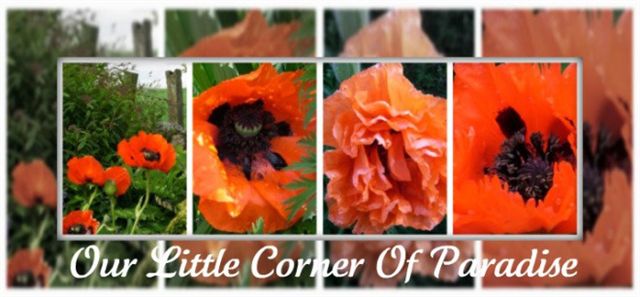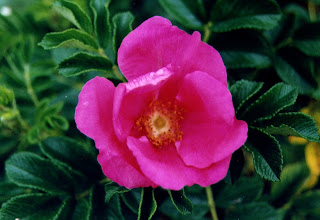The living fence.

The following year we dug out the remains and decided to try again, this time with a deciduous hedge of Rugosa Scabrosa. The word Rugosa means ‘wrinkled,’ and refers to the texture of the leaves, which are disease-free. I read that it would be fast-growing, that, in time, it would spread to form thickets, and that its large tomato-like fruits would attract the birds, with finches in particular, who would come to eat the seeds in Autumn.
We have not been disappointed. The rugosa hedge bears heavily-scented magenta flowers, which bloom from June till September and attract bumble bees. In China and Japan, where the rugosa has been cultivated for a thousand years, the sweetly-scented blooms, four inches across, are used to make pot-pourri.
The stems, covered in thin straight sharp thorns, bear hips which are good for making rose-hip syrup and have leaves which turn bright yellow in Autumn before falling. Winter hardy, and requiring little maintenance, as well as being shade and salt tolerant, the rugosa was a good choice for us as it borders a road which needs regular de-icing.

























3 comments:
Iowa Gardening Woman, correct me if I'm wrong, but I believe what you (Our little Corner of Paradise) are describing are considered invasive weeds in my part of the world. A "shrub" rose that has huge thorns, beautiful flowers and spreads like crazy. I planted this by my house in Moingona and it took over. (Zone 4) It certainly worked as a hedge that kept critters out though.
So glad you visited me! I love your blog and will be back to explore each posting! I garden as much for the creatures it brings as I do for the vegetables & flowers. We already had trees and lots of attractions but I can see some ideas you're sharing that will be wonderful to add. I had so much fun photographing the bees, bugs, frogs and insects visiting my garden. See my Aug 23 & July 18 postings or the critter label.
I also have to explain (or should I bother?) that I let some of the thistle (a non native pest) bloom because of the bees & the birds that use the down. (but I do discourage it from taking over).
I don't know if the Rosa Rugosa Scabrosa is considered a weed in your part of the world or not, Sally. I'll take your knowledge on that.Our hedge has thickened up over the sixteen years, but I've not had any of it seeding around the garden which is amazing considering the tomato-sized hips.
We are of like mind, Petunia. My garden is to encourage the wildlife to come and visit me...to sing to me, buzz around or croak...
Post a Comment